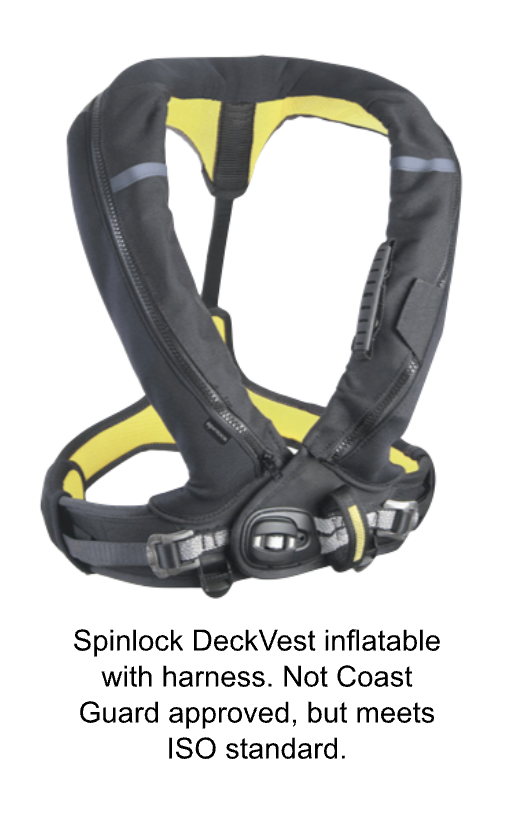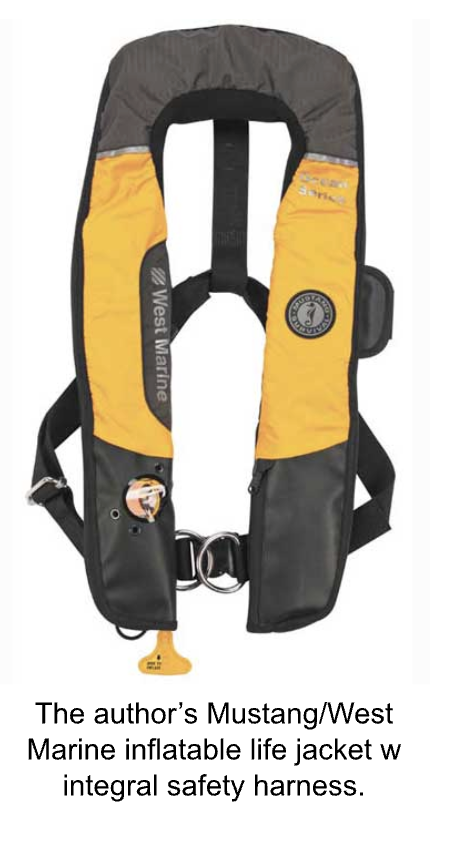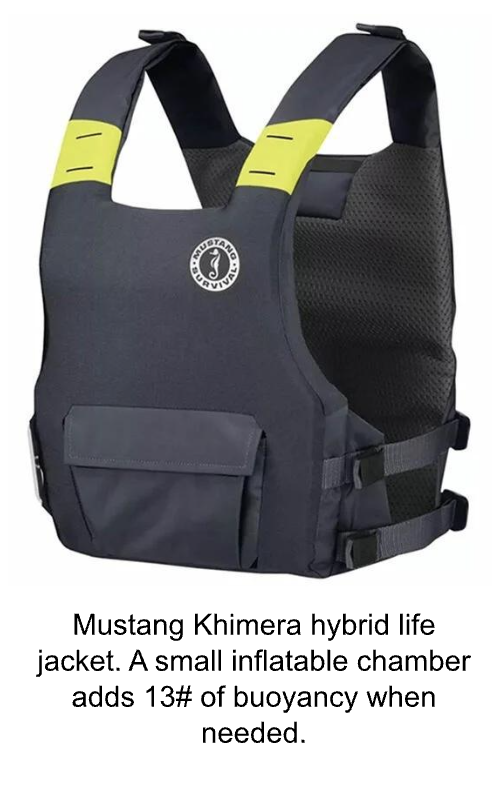The Storm Trysail Club collaborates with several organizations that share our commitment to Seamanship and Safety at Sea, with one of the foremost being the Cruising Club of America (CCA). In addition to its cruising activities, CCA members volunteer to support and organize the Newport Bermuda Race. The CCA and STC share many members, including several who serve on the Safety and Seamanship committees of both organizations. Below is an insightful article on the importance of wearing PFDs. Our thanks to Chuck Hawley and the CCA Safety and Seamanship Committee for sharing this valuable piece. Stay tuned for more in this series over the coming months. This original article was posted on crusingclub.org.
In the first article of this series on life jackets, we examined what a life jacket is intended to do for the wearer. In this article we look at the various ways to create buoyancy for the wearer.
Inherently Buoyancy Life Jackets
Decades ago, when we learned to sail, or waterski, or row, most of us wore life jackets or “life preservers” that used either kapok or Ensolite foam rubber for buoyancy. Kapok fiber comes, not surprisingly, from the kapok tree, where the fiber in its seed pods is long and silky. The fibers cannot be woven, but can be used for stuffing mattresses and, in its marine application, placed in sealed bags that can be used in life jackets. The fiber provides soft “bulk”, and the plastic bags protect the fiber from rot due to water intrusion.
Life jackets are still using synthetic foam rubber, like Ensolite, which provides a low-density, pliable sheet to fashion into dinghy vests, fishing vests, and other shapes and sizes of life jackets. Those materials are used in life jackets with “inherent buoyancy”, meaning that they are buoyant without any actions from the wearer other than wearing them.

There are two common flotation materials: PVC or polyvinyl chloride foam, or PE or polyethylene foams. You can tell the difference in a store because the life jackets made with PE foam are cheaper, and use thin sheets of material which feel a little stiff and they don’t follow the contours of your torso. For real comfort, the PVC foam models are better, and use skived foam for a more comfortable fit.
Because the volume of the life jacket, and therefore the water it displaces, is related to its buoyant force, larger and thicker lifejackets will have more buoyancy. The lowest buoyancy adult life jackets have about 11.2# of buoyant force (which we’ll just call buoyancy from now on.) These are not approved in the U.S., but the original Zhik vests are examples. At the other end of the range, SOLAS vests for commercial vessels will have 35# or 40# buoyancy. People who work on the water (think oil platforms) may wear life jackets with 60# of buoyancy, due to the weight of gear they may have to carry.
Note: in a future article, we’ll discuss buoyancy in both imperial and metric units, but for now, we’re using imperial units (pounds).
In addition to buoyancy, inherently buoyant life jackets may provide additional benefits. The first is hypothermia protection. This depends to a large degree on how well the life jacket fits, since reducing the movement of water near the skin provides a benefit similar to a wetsuit. They are also less likely to “fail”, meaning that they are simple devices and, once donned, are very reliable with no moving or complicated parts, as well as robust construction. Finally, they provide impact protection, most obviously when you wear one for protection when going aloft. But even in an overboard situation, the cushioning of the foam may prevent damage from contact from the boat.
Inflatable Life Jackets
Inflatable life jackets use a cylinder filled with CO2 gas to inflate a chamber made from urethane-coated nylon which provides buoyancy. This inflation can be triggered by the wearer by pulling a lanyard (tab), by a water-activated sensor of some type, or orally using the mouth tube.

The key advantage of an inflatable is that it is compact when deflated, and large and buoyant when inflated. This makes it appropriate for activities that require freedom of movement when on deck (hauling lines, operating winches, steering), without sacrificing in-water performance. Inflatables are available with integral harnesses, making it easy to wear the right personal safety gear when offshore.

Due to the relatively thin fabric of the chamber, inflatables are also more delicate than an inherently-buoyant life jacket, although cases of bursting are thankfully rare. They also require periodic maintenance, which we’ll address in a future article.
Inflatable life jacket buoyancy ranges from around 16# for casual, recreational use, to 35-40# for offshore use in rough conditions. Like inherently buoyant life jackets, there are models with 60# of buoyancy for commercial applications.
Hybrid Life Jackets

Gosh, it would sure be nice to have a life jacket that had the instant, and reliable buoyancy of an inherently buoyant model, with incremental buoyancy and performance when inflated. That’s where the Hybrid life jacket fits in the market. While they have never been very popular, the introduction of models like the Mustang Khimera have made day sailors reconsider their choices. The Khimera, for example, has 7.5# of foam buoyancy, and an additional 13# of buoyancy when the chamber is manually activated.
While the 7.5# of buoyancy is helpful when you initially hit the water, it’s inadequate for non-swimmers and/or rough water for any length of time. The inflatable chamber must be maintained similarly to a “pure” inflatable, and the wearer must know how to activate the CO2 cylinder. While there is an oral inflation tube as a backup, it’s vital to rearm a hybrid life jacket whenever the CO2 has been previously used and to inspect it regularly.
In Conclusion:
While there is more to selecting a life jacket than simply selecting how the device creates buoyancy, you can make some overall observations:
Inherently buoyant:
- Least expensive
- Provides some hypothermia protection and impact protection
- Very reliable
Inflatable:
- Good freedom of movement combined with good in-water performance
- Can be fit with a safety harness
- User must inspect/maintain on a regular schedule
Hybrid Models:
- Slim profile for active sailing/paddling
- Up to 25# of buoyancy for rough waters
- Relatively simple maintenance of inflatable aspect
The Cruising Club of America is a collection of accomplished ocean sailors having extensive boat handling, seamanship, and command experience honed over many years. “Safety Moments” are written by the Club’s Safety Officers from CCA Stations across North America and Bermuda, as well as CCA members at large. They are published by the CCA Safety and Seamanship Committee and are intended to advance seamanship and safety by highlighting new technologies, suggestions for safe operation and reports of maritime disasters around the world.

